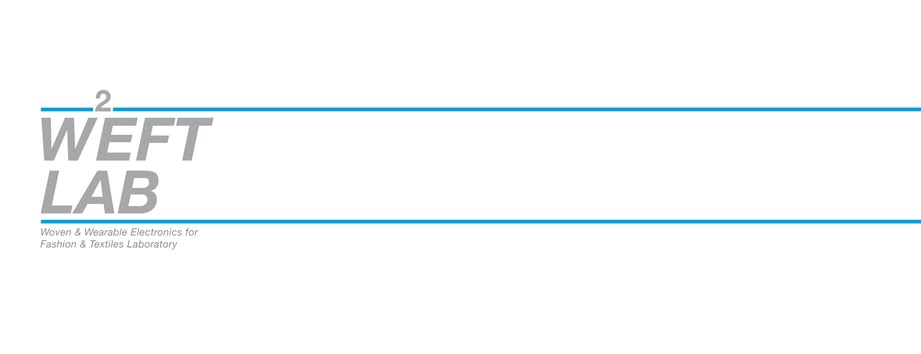 |
| Woven electronic textile by Priti Veja © 2015 |
Weft Lab is an outcome of a PhD research
project by Dr Priti Veja, developed at Brunel University London, College of Engineering, Design
and Physical Sciences (EPSRC supported). The research was published in
March 2015, with thesis title “An investigation of integrated woven electronic
textiles (e-textiles) via design led processes”.
The research focused on woven
e-textiles through design led and empirical investigations, combining
electronics into constructed woven structures. Priti’s research applied woven
methods to make integrated soft circuits, using her expert woven knowledge and
design led processes. Her research demonstrated design considered e-textile
outcomes through woven structural manipulations and design led methods to
amalgamate weaving and electronics as a simultaneous process. The work
investigated e-textiles materials for soft product application, (e.g. wearable
technology, smart textiles) and opportunities for e-textile manufacture. The
research also examined the design process and creative methods applied during
the stages of textile design development.
The thesis is available via open access by directly downloading from BURA (Brunel University ResearchArchive), or via the British Library’s EThOs (E-Theses Online services).
...
 |
| Woven electronic textile by Priti Veja © 2015 |
 |
| Woven electronic textile by Priti Veja © 2015 |
Below is the thesis abstract for an insight of the research.
“Electronic textiles
(e‐textiles) are created by the amalgamation of electronics and textiles,
where electronics are integrated into or onto fabric substrates. Woven textiles
are specifically considered in this thesis to integrate electronics into textiles'
orthogonal architecture. The thesis investigates 'How can the weaving process
be manipulated to make woven e-textiles with integrated electronics?' The
methodological approach taken is practice based research carried out via a
technical materials approach and creative craft methods. An investigation of
woven e-textiles through design led practice and woven expertise is presented.
Previously, woven e-textiles have been investigated either via technical
material approaches, (where the main emphasis remains on function) or via
creative craft methods, (which emphasise experimental forms, manipulate
integration methods and apply craft based knowledge). Both of these approaches
have presented only limited investigation of unobtrusive integrated electronics
in woven e-textiles, and woven structures have not been fully utilised to
support the integration. The research applies reflective practice through a
design process model; this is based on the researcher's previous weaving
expertise and designing methods. The work investigates how woven construction
may be manipulated to develop novel integrated woven e-textiles. It was found
that five woven approaches were particularly of value for electronics
integration. These were the use of double cloth, the integration of multiple
functions into the textiles as part of the weaving, the use of complex weaving
techniques to attach and integrate components, the use of inlay weft weaving
and the manipulation of floats (free floating threads). The thesis makes
original contributions to knowledge, including identification of key stages in
the woven e-textile design process, identification and application of advanced
weaving techniques to facilitate integrated woven e-textiles, and compilation
of a systematic record of woven e-‐textile techniques as a technical woven
repository. Underpinning design principles that influence the developed
e-textile outcomes are identified. A range of woven e-textile samples are
designed and made. Three specific examples including an actuator ('RGB colour
mixer'), a circuit ('corrugated pleat LED v2') and a soft module ('battery
holder module v4'), are described in detail to illustrate their development
using the e-textile design process model. The knowledge gained has potential
to be applied to industrial woven processes for e-textiles.”
Any further inquires regarding this research
can be made to Dr Priti Veja
 |
| Woven electronic textile by Priti Veja © 2015 |


No comments:
Post a Comment